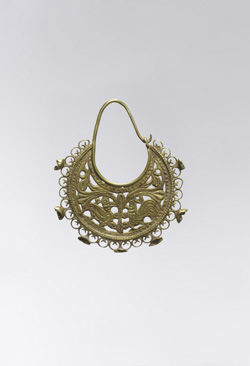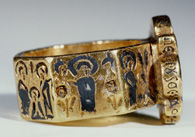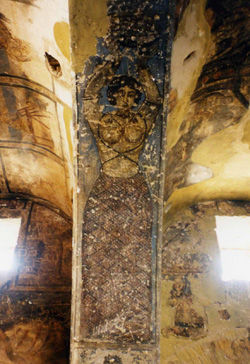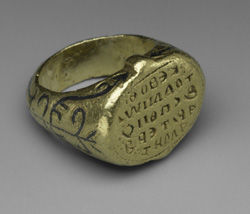Few objects surviving from the Byzantine and early Islamic periods are as instantly relatable to modern sensibilities as examples of jewelry.1 They fascinate us not only for their beauty and preciousness, but also for the sense of immediacy they create as objects that were worn on medieval bodies.
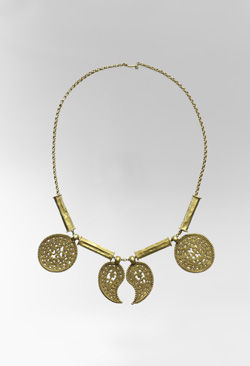
Left: Gold Necklace with Pendants, ca. 7th century. Byzantine. The Metropolitan Museum of Art, New York, Gift of J. Pierpont Morgan, 1917 (17.190.1656); Right: Gold Half Moon-Shaped Earring with Peacocks, late 6th–7th century. Byzantine. The Metropolitan Museum of Art, New York, Rogers Fund, 1938 (38.171.1)
During the Byzantine and early Islamic periods, jewelry both beautified the body and conveyed its owner's wealth. It also commemorated special occasions, such as betrothals or weddings, as in Byzantine women's belts depicting marriage scenes, and in surviving rings enscribed with words like "harmony."
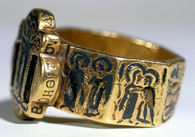
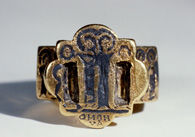
Octagonal Marriage Ring (three views), 7th century. Made in Constantinople(?). Gold and niello. Byzantine Collection, Dumbarton Oaks, Washington, D.C. (BZ.1947.15)
Jewelry also served amuletic functions, protecting wearers against bad luck or harm. Personal adornments in precious metals were furthermore forms of liquid wealth that could be melted down in time of need. Female figures in the frescoes of Qusayr ‘Amra are depicted wearing large pieces of jewelry, giving a sense of the adornments worn by the elegantly attired. One can almost hear the large bracelets, armlets, and anklets of these courtly figures jingling as they dance.
Qusayr ‘Amra dancer. Image: By Javits2000 at en.wikipedia [Public domain], from Wikimedia Commons
Although a great deal of work has been done researching women's personal adornments from this period, it is clear that children and men wore jewelry, too. A mid-eighth-century earthquake in Pella, Jordan, interred a man carrying a dagger and several coins and wearing a single, crescent-shaped gold earring.2 Signet rings feature men's names, as in a tenth-century example naming John, along with his rank as imperial spatharios (swordbearer). Finally, smaller examples that have been found suggest that children also wore jewelry.
Signet Ring of John, Imperial Spatharios, 10th century. Byzantine. Gold, niello. The Metropolitan Museum of Art, New York, Gift of Guy and Valerie Tempest Megargee, 1992 (1992.239)
Additional Reading
Isabella Baldini-Lippolis, L'Orefeceria nell’Impero di Costantinopoli tra IV e VII secolo (Bari, 1999)
Na'ama Brosh, Islamic Jewelry (Jerusalem, 1987)
Von Gladiss, Schmuck im Museum für Islamische Kunst (Berlin, 1998)
Rachel Hasson, Early Islamic Jewellery (Jerusalem, 1987)
Marilyn Jenkins-Medina and Manuel Keene, Islamic Jewelry in the Metropolitan Museum of Art (New York, 1983)Jack Ogden, Jewellery of the Ancient World (New York, 1982
Amilia Yeroulanou, Diatrita: Gold Pierced Work Jewelry from the Third to Seventh Century (Athens, 1999)
[1] Stephen Zwirn, "Jewelry: Ideologies and Transformations," Byzantium and Islam: Age of Transition (New York, 2012), p. 189-190
[2] David Nicolle, The Great Islamic Conquests A.D. 632-750 (Oxford: Osprey Publishing, 2009), p. 35
